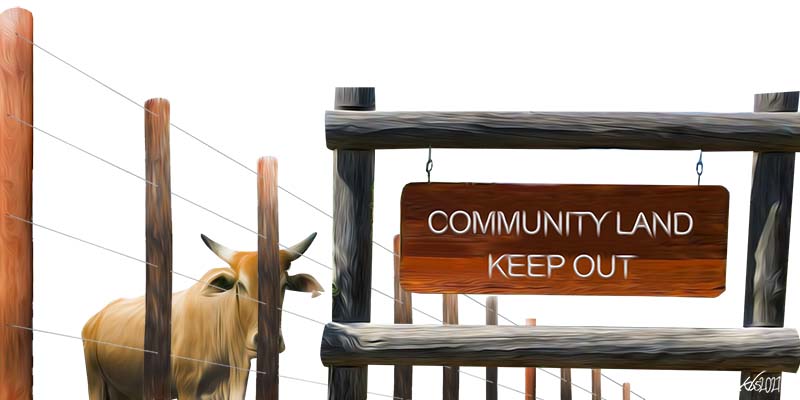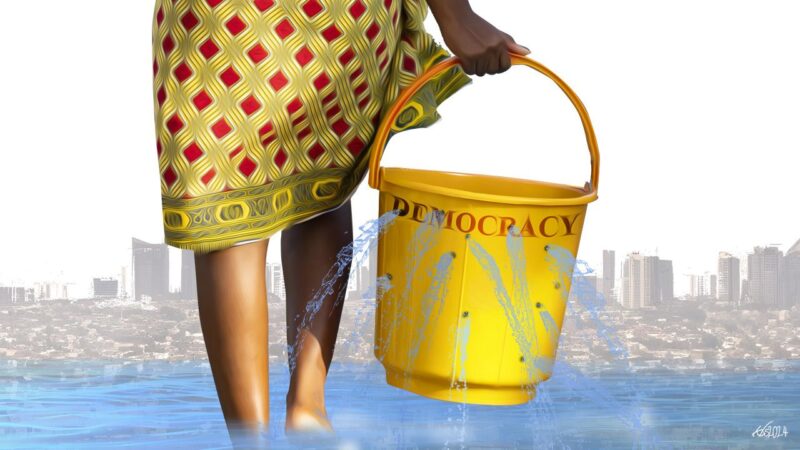With its vast expanses and diversity of wildlife, Kenya – Africa’s original safari destination – attracts over two million foreign visitors annually. The development of wildlife tourism and conservation, a major economic resource for the country, has however been at the cost of local communities who have been fenced off from their ancestral lands. Indigenous communities have been evicted from their territories and excluded from the tourist dollars that flow into high-end lodges and safari companies.
Protected areas with wildlife are patrolled and guarded by anti-poaching rangers and are accessible only to tourists who can afford to stay in the luxury safari lodges and resorts. This model of “fortress conservation” – one that militarizes and privatizes the commons – has come under severe criticism for its exclusionary practices and for being less effective than the models where local communities lead and manage conservation activities.
One such controversial model of conservation in Kenya is the Northern Rangelands Trust (NRT). Set up in 2004, the NRT’s stated goal is “changing the game” on conservation by supporting communities to govern their lands through the establishment of community conservancies.
Created by Ian Craig, whose family was part of the elite white minority during British colonialism, the NRT’s origins date back to the 1980s when his family-owned 62,000-acre cattle ranch was transformed into the Lewa Wildlife Conservancy. Since its founding, the NRT has set up 39 conservancies on 42,000 square kilometres (10,378,426 acres) of land in northern and coastal Kenya – nearly 8 per cent of the country’s total land area.
The communities that live on these lands are predominantly pastoralists who raise livestock for their livelihoods and have faced decades of marginalization by successive Kenyan governments. The NRT claims that its goal is to “transform people’s lives, secure peace and conserve natural resources.”
However, where the NRT is active, local communities allege that the organization has dispossessed them of their lands and deployed armed security units that have been responsible for serious human rights abuses. Whereas the NRT employs around 870 uniformed scouts, the organization’s anti-poaching mobile units, called ‘9’ teams, face allegations of extrajudicial killings and disappearances, among other abuses. These rangers are equipped with military weapons and receive paramilitary training from the Kenyan Wildlife Service Law Enforcement Academy and from 51 Degrees, a private security company run by Ian Craig’s son, Batian Craig, as well as from other private security firms. Whereas the mandate of NRT’s rangers is supposed to be anti-poaching, they are routinely involved in policing matters that go beyond that remit.
Locals allege that the NRT compels communities to set aside their best lands for the exclusive use of wildlife.
Locals have alleged the NRT’s direct involvement in conflicts between different ethnic groups, related to territorial issues and/or cattle raids. Multiple sources within the impacted communities, including members of councils of community elders, informed the Oakland Institute that as many as 76 people were killed in the Biliqo Bulesa Conservancy during inter-ethnic clashes, allegedly with the involvement of the NRT. Interviews conducted by the Institute established that 11 people have been killed in circumstances involving the conservation body. Dozens more appear to have been killed by the Kenya Wildlife Services (KWS) and other government agencies, which have been accused of abducting, disappearing, and torturing people in the name of conservation.
Over the years, conflicts over land and resources in Kenya have been exacerbated by the establishment of large ranches and conservation areas. For instance, 40 per cent of Laikipia County’s land is occupied by large ranches, controlled by just 48 individuals – most of them white landowners who own tens of thousands of acres for ranching or wildlife conservancies, which attract tourism business as well as conservation funding from international organizations.
Similarly, several game reserves and conservancies occupy over a million acres of land in the nearby Isiolo County. Land pressure was especially evident in 2017 when clashes broke out between private, mostly white ranchers, and Samburu and Pokot herders over pasture during a particularly dry spell.
But as demonstrated in the Oakland Institute’s report Stealth Game, the events of 2017 highlighted a situation that has been rampant for many years. Local communities report paying a high price for the NRT’s privatized, neo-colonial conservation model in Kenya. The loss of grazing land for pastoralists is a major challenge caused by the creation of community conservancies. Locals allege that the NRT compels communities to set aside their best lands for the exclusive use of wildlife in the name of community conservancies, and to subsequently lease it to set up tourist facilities.
Although terms like “community-driven”, “participatory”, and “local empowerment” are extensively used by the NRT and its partners, the conservancies have been allegedly set up by outside parties rather than the pastoralists themselves, who have a very limited role in negotiating the terms of these partnerships. According to several testimonies, leverage over communities occurs through corruption and co-optation of local leaders and personalities as well as the local administration.
A number of interviewees allege intimidation, including arrests and interrogation of local community members and leaders, as tactics routinely used by the NRT security personnel. Furthermore, the NRT is involved not just in conservation but also in security, management of pastureland, and livestock marketing, which according to the local communities, gives it a level of control over the region that surpasses even that of the Kenyan government. The NRT claims that these activities support communities, development projects, and help build sustainable economies, but its role is criticized by local communities and leaders.
In recent years, hundreds of locals have held protests and signed petitions against the presence of the NRT. The Turkana County Government expelled the NRT from Turkana in 2016; Isiolo’s Borana Council of Elders (BCE) and communities in Isiolo County and in Chari Ward in the Biliqo Bulesa Conservancy continue to challenge the NRT. In January 2021, the community of Gafarsa protested the NRT’s expansion into the Gafarsa rangelands of Garbatulla sub-county. And in April 2021, the Samburu Council of Elders Association, a registered institution representing the Samburu Community in four counties (Isiolo, Laikipia, Marsabit and Samburu), wrote to international NGOs and donors asking them to cease further funding and to audit the NRT’s donor-funded programmes.
A number of interviewees allege intimidation, including arrests and interrogation of local community members and leaders, as tactics routinely used by the NRT security personnel.
At the time of the writing of the report, the Oakland Institute reported that protests against the NRT were growing across the region. The organization works closely with the KWS, a state corporation under the Ministry of Wildlife and Tourism whose mandate is to conserve and manage wildlife in Kenya. In July 2018, Tourism and Wildlife Cabinet Secretary Najib Balala, appointed Ian Craig and Jochen Zeitz to the KWS Board of Trustees. The inclusion of Zeitz and Craig, who actively lobby for the privatization of wildlife reserves, has been met with consternation by local environmentalists. In the case of the NRT, the relationship is mutually beneficial – several high-ranking members of the KWS have served on the NRT’s Board of Trustees.
Both the NRT and the KWS receive substantial funding from donors such as USAID, the European Union, and other Western agencies, and champion corporate partnerships in conservation. The KWS and the NRT also partner with some of the largest environmental NGOs, including The Nature Conservancy (TNC), whose corporate associates have included major polluters and firms known for their negative human rights and environmental records, such as Shell, Ford, BP, and Monsanto among others. In turn, TNC’s Regional Managing Director for Africa, Matt Brown, enjoys a seat at the table of the NRT’s Board of Directors.
Stealth Game also reveals how the NRT has allegedly participated in the exploitation of fossil fuels in Kenya. In 2015, the NRT formed a five-year, US$12 million agreement with two oil companies active in the country – British Tullow Oil and Canadian Africa Oil Corp – to establish and operate six community conservancies in Turkana and West Pokot Counties.
The NRT’s stated goal was to “help communities to understand and benefit” from the “commercialisation of oil resources”. Local communities allege that it put a positive spin on the activities of these companies to mask concerns and outstanding questions over their environmental and human rights records.
The NRT, in collaboration with big environmental organizations, epitomizes a Western-led approach to conservation that creates a profitable business but marginalizes local communities who have lived on these lands for centuries.
Despite its claims to the contrary, the NRT is yet another example of how fortress conservation, under the guise of “community-based conservation”, is dispossessing the very pastoralist communities it claims to be helping – destroying their traditional grazing patterns, their autonomy, and their lives.
The Constitution of Kenyan 2010 and the 2016 Community Land Act recognize community land as a category of land holding and pastoralism as a legitimate livelihood system. The Act enables communities to legally register, own, and manage their communal lands. For the first three years, however, not a single community in Kenya was able to apply to have their land rights legally recognized. On 24 July 2019, over 50 representatives from 11 communities in Isiolo, Kajiado, Laikipia, Tana River, and Turkana counties were the first to attempt to register their land with the government on the basis of the Community Land Act. The communities were promised by the Ministry of Land that their applications would be processed within four months. In late 2020, the Ministry of Lands registered the land titles of II Ngwesi and Musul communities in Laikipia.
The others are still waiting to have their land registered. In October 2020, the Lands Cabinet Secretary was reported saying that only 12 counties have submitted inventories of their respective unregistered community lands in readiness for the registration process as enshrined in the law.
Community members interviewed by the Oakland Institute in the course of its research repeatedly asked for justice after years of being ignored by the Kenyan government and by the police when reporting human rights abuses and even killings of family members. The findings reported in Stealth Game require an independent investigation into the land-related grievances around all of the NRT’s community conservancies, the allegations of involvement of the NRT’s rapid response units in inter-ethnic conflict, as well as the alleged abuses and extrajudicial killings.
Pastoralists have been the custodians of wildlife for centuries – long before any NGO or conservation professionals came along. While this report focuses on the plight of the Indigenous communities in Northern Kenya, it is a reality that is all too familiar to indigenous communities the world over. In far too many places, national governments, private corporations, and large conservation groups collude in the name of conservation, not just to force Indigenous groups off their land, but to force them out of existence altogether.
Pastoralists have been the custodians of wildlife for centuries – long before any NGO or conservation professionals came along.
The latest threat comes from the so-called “30×30 initiative”, a plan under the UN’s Convention on Biological Diversity that calls for 30 per cent of the planet to be placed in protected areas – or for other effective area-based conservation measures (OECMs) – by 2030.
The Oakland Institute’s report, Stealth Game, makes it clear that fortress conservation must be replaced by Indigenous-led conservation efforts in order to preserve the remaining biodiversity of the planet while respecting the interests, rights, and dignity of the local communities.








